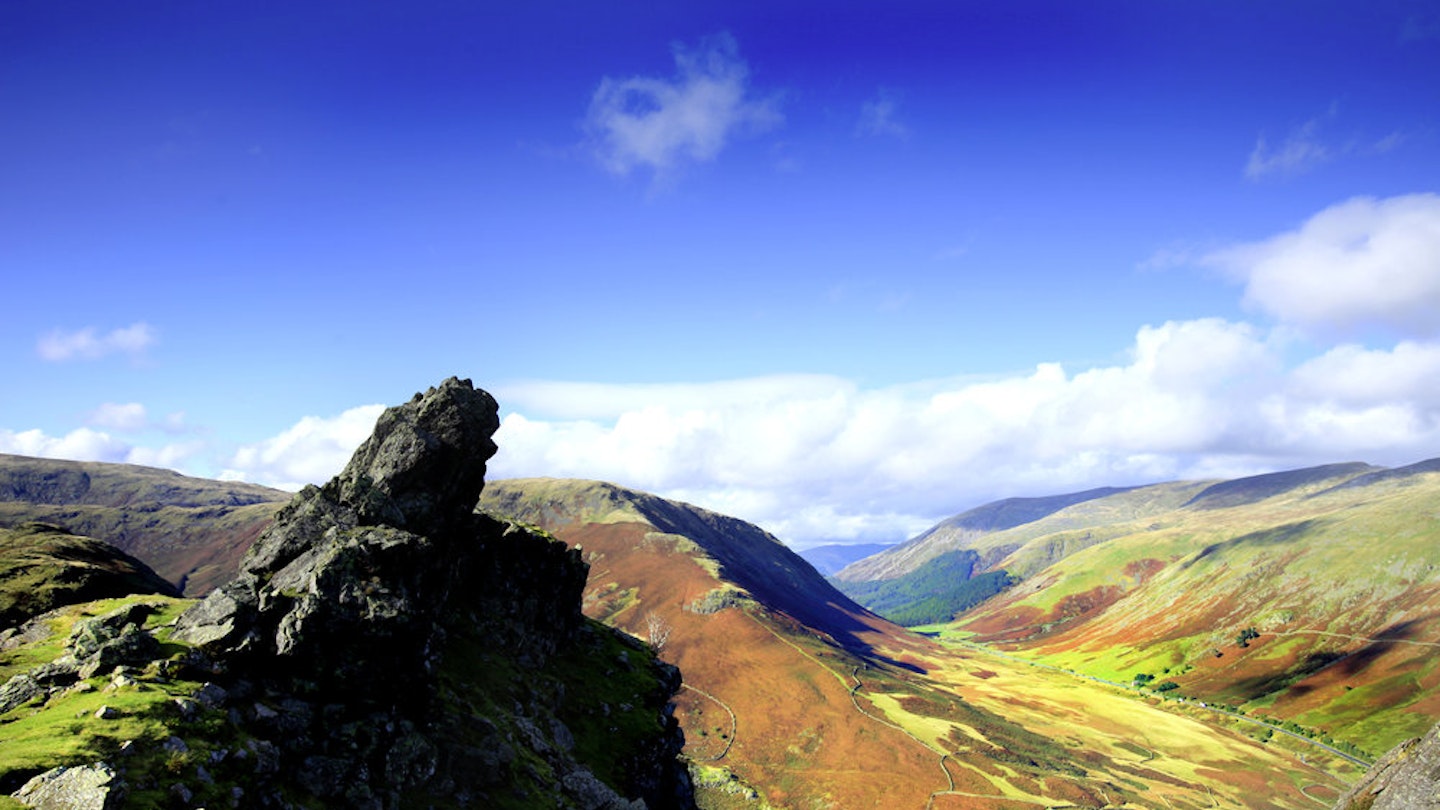Believe it or not, the UK’s most famous hillwalker isn’t universally adored. While his Pictorial Guides are undoubtedly things of great beauty, there are those who think it important to remember that the fells were there long before Alfred Wainwright set his shoes upon them and, for that matter, Lakeland was admired for its vast wealth of natural loveliness prior to him putting pen to paper to capture the views in his (admittedly exquisite) sketches. His books may have introduced many newcomers to the wonder of a wander in the hills, but detractors of AW will observe that there’s a certain irony to this, given how loath he was to share them with anybody. For those people, then, the fact that there’s a fell out there that ranks among Lakeland’s 214 ‘Wainwrights’, but whose summit the great man never actually reached, is in itself an attraction.
But there are better reasons for climbing Helm Crag. Tucked neatly in the centre of the Lake District overlooking Grasmere village, what Helm Crag lacks in height it more than makes up for in character. It is an angular fell, dropping sharply over harsh crags to the north-east, and less roughly but equally steeply southwards. To the north-east it is separated from Gibson Knot by the col of Bracken Hause, before the ridge sweeps onwards around the north of Grasmere Common.
On its modest-sized plate, Helm Crag serves up the varied delights of the Lake District
as a whole in one easily digestible course. Intimidating, however, Helm Crag is not. Winding up through the dappled light of the forested lower slopes, the going is gentle. Even when the terrain steepens and the well-worn path becomes more of a pull, it is just that: a steep but non-threatening path. And when, after far fewer minutes than it takes to climb even halfway up some of Helm Crag’s loftier neighbours, the track arrives on the narrow-backed and grass-carpeted summit, there’s nothing to indicate why a man with as many fells, ridges and rakes under his belt as Alfred Wainwright couldn’t have made it to the top. Except this isn’t the top, and only now is it apparent why getting to it presents something of a challenge. The final 7 or so of Helm Crag’s 405 metres are made up of bare, near-vertical rock. This angular chunk of mountain in miniature leans out over the crags of the north-eastern slopes, a stone prow breaking free of the wave of hillside and teetering above the precipice. To claim the summit, it needs to be tackled, and this is out-and-out scrambling territory.
.jpeg?auto=format&w=1440&q=80)
Getting started is simple. The rocks at the foot of the pillar are broken and spread. The first few feet are no more taxing than rock-pool clambering. Foot- and hand-holds are plentiful, and there are multiple lines to take – you can more or less follow your nose as you climb. The difficulty comes as you pass the halfway point. You’re now far enough from where you started that, were you to fall, although it probably wouldn’t be fatal, it would most definitely hurt. Holds can still be found, but they’re a little thinner on the ground and less reassuring. In wet weather, the rock can be treacherous, particularly if you’re following the slab line up the west side. Moves require more thought; working out exactly where your hands and feet are going to go needs to be considered in advance. Then, as you near the top, another factor comes into play.
The upper sections of the rock overhang a not inconsiderable drop. A fall here would almost definitely be fatal and painful, but not necessarily in that order. For that reason, you can be forgiven for claiming the summit with a tap of the hand on the top. But if the weather’s good, the rock dry, your legs solid and your head for heights robust, it is possible to pull yourself onto the crest and stand upright. It is a position of some precariousness; but the scenery is spectacular, with views over all the Grasmeres: water, village and common. You still need to get down and, as is the way with scrambling, this is the hardest part. Feeling your way with your feet requires care, particularly where ledges and cracks are not always obvious from above. Ensuring you don’t let go of anything solid until your other hands or feet are on something equally sturdy is sensible. It may take slightly longer to get down than it did to get up, but nobody’s timing you. And if they are, ignore them. Once you’re back among the boulders below, take a moment to look back up and enjoy what you’ve just done. It may not be graded, and you’re unlikely to see it in any scrambling guidebook, but it is a scramble, and it’s one of Lakeland’s iconic boxes that every fellwalker should aim to tick.
.jpeg?auto=format&w=1440&q=80)
In many ways, Helm Crag’s crown is the perfect learner slope for the newbie scrambler. The moves get gradually more difficult, but never too tricky to climb down from. The distance covered is small by regular scramble comparisons, yet the exposure caused by the overhang makes it as collywobbles-inducing as far loftier rock routes. So don’t let the lack of yardage belittle your achievement. If you’ve bagged Helm Crag’s true summit you can feel proud. After all, you’re one up on old AW. Stick that in your pipe and smoke it, Alf.
WORDS BEN WEEKS
This article first appeared in Trail Magazine
